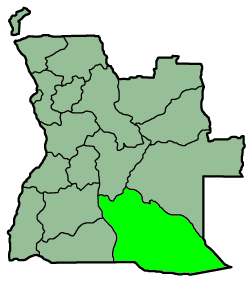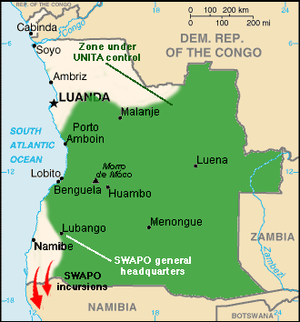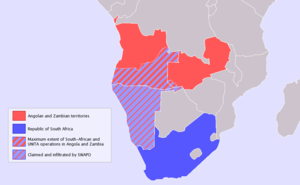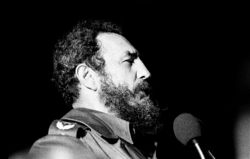التدخل الكوبي في أنگولا
| Cuban intervention in Angola | |||||||
|---|---|---|---|---|---|---|---|
| جزء من Angolan Civil War | |||||||
 Location of Cuba (red), Angola (green), and South Africa (blue), including South West Africa | |||||||
| |||||||
| المتحاربون | |||||||
|
Material support:
|
| ||||||
| القوى | |||||||
|
Total Cuban troops:
|
| ||||||
| الضحايا والخسائر | |||||||
|
10,000–15,000 killed, wounded or missing[24][25] 56,000 deserters[26][27] |
| ||||||
The Cuban intervention in Angola (codenamed Operation Carlota) began on 5 November 1975, when Cuba sent combat troops in support of the communist-aligned People's Movement for the Liberation of Angola (MPLA) in against the pro-western National Union for the Total Independence of Angola (UNITA) and National Liberation Front of Angola (FNLA). The intervention came after the outbreak of the Angolan Civil War, which occurred after the former Portuguese colony was granted independence after the Angolan War of Independence. The civil war quickly became a proxy war between the Eastern Bloc led by the Soviet Union and the Western Bloc led by the United States. South Africa and the United States backed UNITA and the FNLA, while communist nations backed the MPLA.[31][32] 4,000 Cuban troops helped to turn back a three-pronged advance by the SADF and Zairean troops, backed up by foreign mercenaries. [33] Later, 18,000 Cuban troops defeated the FNLA in the north and UNITA in the south.[33] Separatists from the Front for the Liberation of the Enclave of Cabinda (FLEC) fought the Cubans but were defeated. In 1976, the Cuban military in Angola reached 36,000 troops. Following the withdrawal of Zaire and South Africa (March 1976), Cuban forces remained in Angola to support the MPLA government against UNITA in the continuing civil war.[34] South Africa spent the following decade launching bombing and strafing raids from its bases in South West Africa into southern Angola, while UNITA engaged in ambushes, hit-and-run attacks, and harassment of Cuban units.[35]
In 1988, Cuban troops (increased to about 55,000) intervened again to avert military disaster in a Soviet-led People's Armed Forces for the Liberation of Angola (FAPLA) offensive against UNITA, which was still supported by South Africa, leading to the Battle of Cuito Cuanavale and the opening of a second front.[36] This turn of events is considered to have been the major impetus to the success of the ongoing peace talks leading to the New York Accords, the agreement by which Cuban and South African forces withdrew from Angola while South West Africa gained its independence from South Africa.[37][38][39][40][41] Cuban military engagement in Angola ended in 1991, while the Angolan Civil War continued until 2002. Cuban casualties in Angola totaled approximately 10,000 dead, wounded or missing.[42][43]
. . . . . . . . . . . . . . . . . . . . . . . . . . . . . . . . . . . . . . . . . . . . . . . . . . . . . . . . . . . . . . . . . . . . . . . . . . . . . . . . . . . . . . . . . . . . . . . . . . . . . . . . . . . . . . . . . . . . . . . . . . . . . . . . . . . . . . . . . . . . . . . . . . . . . . . . . . . . . . . . . . . . . . . .
خلفية
فشل اتفاقية ألڤور والحرب الأهلية
جنوب أفريقيا تتدخل
المهمة العسكرية الكوبية
التدخل الكوبي الأول
العملية كارلوتا
الجبهة الشمالية وكابندا
The invasion of Cabinda was conducted by three FLEC and one Zairian infantry battalions under the command of 150 French and American mercenaries. The MPLA's had the 232 Cubans of the CIR, a freshly trained and an untrained FAPLA infantry battalion at its disposal. In the ensuing battle for Cabinda from 8–13 November they managed to repel the invasion without support from Operation Carlota, thus saving the exclave for the MPLA.[44]
الجبهة الجنوبية
SADF advance is stopped
التجميع
Proxy war, UN resolutions and negotiations (late 1970s and 1980s)

التدخل الثاني لكوبا
تصعيد النزاع
As a result of the South African Operation Askari in December 1983, which targeted People's Liberation Army of Namibia bases inside Angola, the USSR not only increased its aid to the MPLA but also took over the tactical and strategic leadership of FAPLA, deploying advisors right down to the battalion level,[45] and began planning a large-scale offensive against the UNITA-stronghold in southeastern Angola.
. . . . . . . . . . . . . . . . . . . . . . . . . . . . . . . . . . . . . . . . . . . . . . . . . . . . . . . . . . . . . . . . . . . . . . . . . . . . . . . . . . . . . . . . . . . . . . . . . . . . . . . . . . . . . . . . . . . . . . . . . . . . . . . . . . . . . . . . . . . . . . . . . . . . . . . . . . . . . . . . . . . . . . . .
كويتو كواناڤالي
كوبا و the Three Powers Accord
الأعقاب
انظر أيضاً
- South African Border War
- الحرب الأهلية الأنگولية
- Mallin, Jay (1987). Cuba in Angola. Coral Gables, Fla.: Research Institute for Cuban Studies, Graduate School of International Studies, University of Miami. OCLC 17560083.
الهامش
- ^ أ ب Shubin, Vladimir Gennadyevich (2008). The Hot "Cold War": The USSR in Southern Africa. London: Pluto Press. pp. 92–93, 249. ISBN 978-0-7453-2472-2.
- ^ Thomas, Scott (1995). The Diplomacy of Liberation: The Foreign Relations of the ANC Since 1960. London: Tauris Academic Studies. pp. 202–207. ISBN 978-1850439936.
- ^ Wolfe, Thomas; Hosmer, Stephen (1983). Soviet policy and practice toward Third World conflicts. Lanham: Rowman & Littlefield. p. 87. ISBN 978-0669060546.
- ^ أ ب ت ث Hughes, Geraint (2014). My Enemy's Enemy: Proxy Warfare in International Politics. Brighton: Sussex Academic Press. pp. 65–79. ISBN 978-1845196271.
- ^ Vanneman, Peter (1990). Soviet Strategy in Southern Africa: Gorbachev's Pragmatic Approach. Stanford: Hoover Institution Press. pp. 41–57. ISBN 978-0817989026.
- ^ Chan, Stephen (2012). Southern Africa: Old Treacheries and New Deceits. New Haven, Connecticut: Yale University Press. pp. 42–46. ISBN 978-0300184280.
- ^ Mitchell, Thomas G. (2013). Israel/Palestine and the Politics of a Two-State Solution. Jefferson: McFarland & Company Inc. pp. 94–99. ISBN 978-0-7864-7597-1.
- ^ Shubin, Vladimir; Shubin, Gennady; Blanch, Hedelberto (2015). Liebenberg, Ian; Risquet, Jorge (eds.). A Far-Away War: Angola, 1975-1989. Stellenbosch: Sun Press. pp. 86–87. ISBN 978-1920689728.
- ^ James III, W. Martin (2011) [1992]. A Political History of the Civil War in Angola: 1974-1990. New Brunswick: Transaction Publishers. pp. 207–214, 239–245. ISBN 978-1-4128-1506-2.
- ^ Polack, Peter (13 ديسمبر 2013). The Last Hot Battle of the Cold War: South Africa vs. Cuba in the Angolan Civil War. Casemate Publishers. pp. 66–68. ISBN 9781612001951.
- ^ https://www.globalwitness.org/en/archive/all-presidents-men/
- ^ "Cuban Tanks".
- ^ أ ب ت "La Guerras Secretas de Fidel Castro" Archived 18 يناير 2012 at the Wayback Machine (in Spanish). CubaMatinal.com. Retrieved 9 March 2013.
- ^ Gleijeses, Piero (2013). Visions of Freedom: Havana, Washington, Pretoria, and the Struggle for Southern Africa, 1976-1991. UNC Press Books. p. 521.
- ^ Risquet Valdés (2007: xlvii)
- ^ Risquet Valdés 2008: 102
- ^ Saul David (2009). War. ISBN 9781405341332. Retrieved 9 مارس 2013.
- ^ Andrei Mikhailov (15 فبراير 2011). "Soviet Union and Russia lost 25,000 military men in foreign countries". English pravda.ru. Retrieved 18 أغسطس 2013.
- ^ Irving Louis Horowitz (1995). Cuban Communism, 8th Edition. ISBN 9781412820899. Retrieved 9 مارس 2013.
- ^ Angola – Independence Struggle, Civil War, and Intervention. MongaBay.com.
- ^ Political terrorism: a new guide to actors, concepts, data bases, theories and literature.
- ^ أ ب Clodfelter, Micheal (2017). Warfare and Armed Conflicts: A Statistical Encyclopedia of Casualty and Other Figures, 1492-2015, 4th ed. McFarland. p. 566. ISBN 978-0786474707.
- ^ Polack, Peter (2013). The Last Hot Battle of the Cold War: South Africa vs. Cuba in the Angolan Civil War (illustrated ed.). Oxford: Casemate Publishers. pp. 164–171. ISBN 978-1612001951.
- ^ Mallin, Jay (1994). Covering Castro: Rise and Decline of Cuba's Communist Dictator. Transaction Publishers. p. 101.
- ^ Shubin, Gennadiĭ Vladimirovich; Tokarev, Andreĭ Aleksandrovich (2011). Bush Wars: The Road to Cuito Cuanavale. ISBN 9781431401857. Retrieved 18 أغسطس 2013.
- ^ http://www.nytimes.com/1987/07/01/world/cuba-is-mired-in-angola-top-defector-says.html.
- ^ Horowitz, Irving Louis (1995). Cuban Communism/8th Editi. Transaction Publishers. p. 560.
- ^ "Soviet Union and Russia lost 25,000 military men in foreign countries – English Pravda". English.pravda.ru. 15 فبراير 2011. Retrieved 18 أغسطس 2013.
- ^ Akawa, Martha; Silvester, Jeremy (2012). "Waking the dead: civilian casualties in the Namibian liberation struggle" (PDF). Windhoek, Namibia: University of Namibia. Archived from the original (PDF) on 10 نوفمبر 2016. Retrieved 4 يناير 2015.
- ^ Reginald Herbold Green. "Namibia : The road to Namibia – Britannica Online Encyclopedia". Britannica.com. Retrieved 15 يناير 2013.
- ^ George, p. 1
- ^ Smith, pp. 66, 71-72
- ^ أ ب Clodfelter 2017, p. 566.
- ^ Africa, Problems & Prospects: A Bibliographic Survey. U.S. Department of the Army. 1977. p. 221.
- ^ James III, W. Martin (2020). A Political History of the Civil War in Angola, 1974-1990. Routledge. p. 11.
- ^ Vanneman, Peter (1990). Soviet Strategy in Southern Africa: Gorbachev's Pragmatic Approach. Hoover Press. p. 40.
- ^ George, p. 3
- ^ Film Une Odyssée Africaine (France, 2006, 59 min) directed by: Jihan El Tahri
- ^ Gleijeses
- ^ Cuito Cuanavale – "Afrikas Stalingrad", Ein Sieg über Pretorias Apartheid" in: Neues Deutschland, 19/20 April. 2008
- ^ Campbell, Horace: The Military Defeat of the South Africans in Angola in: Monthly Review, April 1989
- ^ Mallin, Jay (1994). Covering Castro. Transaction Publishers.
- ^ Horowitz, Irving Louis (1995). Cuban Communism/8th Editi. Transaction Publishers. p. 560.
- ^ George, pp. 82-86
- ^ Peter Vanneman (1990). Soviet strategy in Southern Africa: Gorbachev's pragmatic approach. Hoover Press. p. 29. ISBN 0-8179-8901-3.
ببليوگرافيا
- George, Edward The Cuban Intervention in Angola, 1965-1991, Frank Cass, London, New York, 2005, ISBN 0-415-35015-8
- Gleijeses, Piero: Conflicting Missions: Havana, Washington, and Africa, 1959-1976, The University of North Carolina Press, 2003 ISBN 0-8078-5464-6
- Smith, Wayne: A Trap in Angola in: Foreign Policy No. 62, Spring 1986, Carnegie Endowment for International Peace
للاستزادة
- Stockwell, John: In Search of Enemies: A CIA Story, New York, USA: W. W. Norton & Co., 1978, ISBN 0-393-05705-4
- Minter, William: Apartheid's Contras: An Inquiry into the Roots of War in Angola and Mozambique, Johannesburg, South Africa: Witwatersrand University Press, 1994
- Klinghoffer, Arthur Jay: The Angolan War: A Study in Soviet Policy in the Third World, Boulder, Colorado, USA: Westview Press, 1980
- Guimaraes, Fernando Andresen: The Origins of the Angolan Civil War, London, England: Macmillan Press Ltd, 1998, ISBN 0-312-17512-4
- Brittain, Victoria: Death of Dignity: Angola's Civil War, London, England: Pluto Press, 1998, ISBN 0-7453-1252-7
- Wolfers, Michael: Angola in the Front Line, London: Zed Books, 1983, ISBN 978-0862321062
- Marcum, John A.: The Angolan Revolution, Vol. II, Exile Politics and Guerrilla Warfare (1962–1976), Cambridge, Massachusetts, USA and London, England: The MIT-Press, ISBN 0-262-13136-6
- James, W. Martin: A Political History of the Civil War in Angola 1974-1990, New Brunswick, USA, and London, England: Transaction Publishers, 1992
- Spikes, Daniel, Angola and the Politics of Intervention: From Local Bush War to Chronic Crisis in Southern Africa, Jefferson, North Carolina, and London: McFarland & Company, 1993, ISBN 0-89950-888-X
- Ignatiev, Oleg: Secret Weapon in Africa, Moscow, Russia: Progress Publishers, 1977
- Kitchen, Helen: Angola, Mozambique, and the West, Praeger, 1987
- ICAIC (Instituto Cubano del Arte e Industria Cinematográficos)
- Gleijeses, Piero: Kuba in Afrika 1975–1991. In: Bernd Greiner /Christian Th. Müller / Dierk Walter (Hrsg.): Heiße Kriege im Kalten Krieg. Hamburg, 2006, ISBN
- Gleijeses, Piero, "Moscow's Proxy? Cuba and Africa 1975–1988", Journal of Cold War Studies 8.4 (2006) 98-146 Copyright © 2006 by the President and Fellows of Harvard College and the Massachusetts Institute of Technology.
- Departement Sozialwissenschaften der Universität Hamburg über den Krieg in Angola (Hamburg University)
- Deutsches Auswärtiges Amt zur Geschichte Angolas (German foreign ministry)
- Welt Online: Wie Castro die Revolution exportierte
- The National Security Archive: Secret Cuban Documents on Africa Involvement
- Saney, Isaac, "African Stalingrad: The Cuban Revolution, Internationalism and the End of Apartheid", Latin American Perspectives, Vol. 33, No. 5 (September 2006): pp. 81–117.
- Mandela, Nelson, & Fidel Castro, How Far We Slaves Have Come! New York: Pathfinder Press, 1991, ISBN 978-0-87348-729-0
- Pazzanita, Anthony G., "The Conflict Resolution Process in Angola." The Journal of Modern African Studies Vol. 29 No 1 (March 1991): pp. 83–114.
- Truth and Reconciliation Commission of South Africa, Truth and Reconciliation Commission of South Africa Report: Volume Two: Repression and Resistance
- Crocker, Chester A., High Noon in Southern Africa: Making Peace in a Rough Neighborhood. New York: W. W. Norton, 1992.
- Peter Stiff, The Silent War: South African Recce Operations 1969–1994. Alberton, South Africa: Galago, 1999.
- Henry Kissinger, Years of Renewal. New York: Simon & Schuster, 1999. ISBN 0-684-85571-2
- Marrack Goulding, Peacemonger. Baltimore: Johns Hopkins University Press, 2003
- Willem Steenkamp, South Africa's Border War, 1966–1989. Gibraltar: Ashanti Publishing, 1989
- Roger Ricardo Luis, Prepárense a vivir: Crónicas de Cuito Cuanavale. Havana: Editora Politica, 1989
- Wright, George, The Destruction of a Nation: United States' Policy Toward Angola Since 1945, London: Pluto Press, 1997 ISBN 978-0-7453-1030-5
- Castro, Fidel, Jorge Risquet, and Gabriel García Márquez, Changing the History of Africa: Angola and Namibia, Melbourne: Ocean Press, 1989
- Polack, Peter, Last Hot Battle of the Cold War: South Africa vs. Cuba in the Angolan Civil War. Casemate, 2013. ISBN 978-1612001951.
وصلات خارجية
- CIA & Angolan Revolution 1975 Part 1 at YouTube
- CIA & Angolan Revolution 1975 Part 2 at YouTube
- John Stockwell on the CIA, Angola and Jonas Savimbi at YouTube
- South Africa: Cuba and the South African Anti-Apartheid Struggle by Nicole Sarmiento
- Village of the Living Dead: With the Cubans in Angola
قالب:South African Border War
خطأ استشهاد: وسوم <ref> موجودة لمجموعة اسمها "note"، ولكن لم يتم العثور على وسم <references group="note"/>
- Short description matches Wikidata
- Use dmy dates from May 2016
- Pages with empty portal template
- تاريخ كوبا
- العلاقات العسكرية الأنگولية الكوبية
- التاريخ العسكري لكوبا
- حروب كوبا
- South African Border War
- يونيتا
- الحرب الباردة في أفريقيا
- حروب جنوب أفريقيا
- حروب جمهورية الكونغو الديمقراطية
- فيدل كاسترو
- الحرب الأهلية الأنگولية
- التاريخ العسكري لأنگولا
- القرن العشرون في كوبا
- القرن العشرون في أنگولا
- نزاعات الحرب الباردة
- الشيوعية في أنگولا




